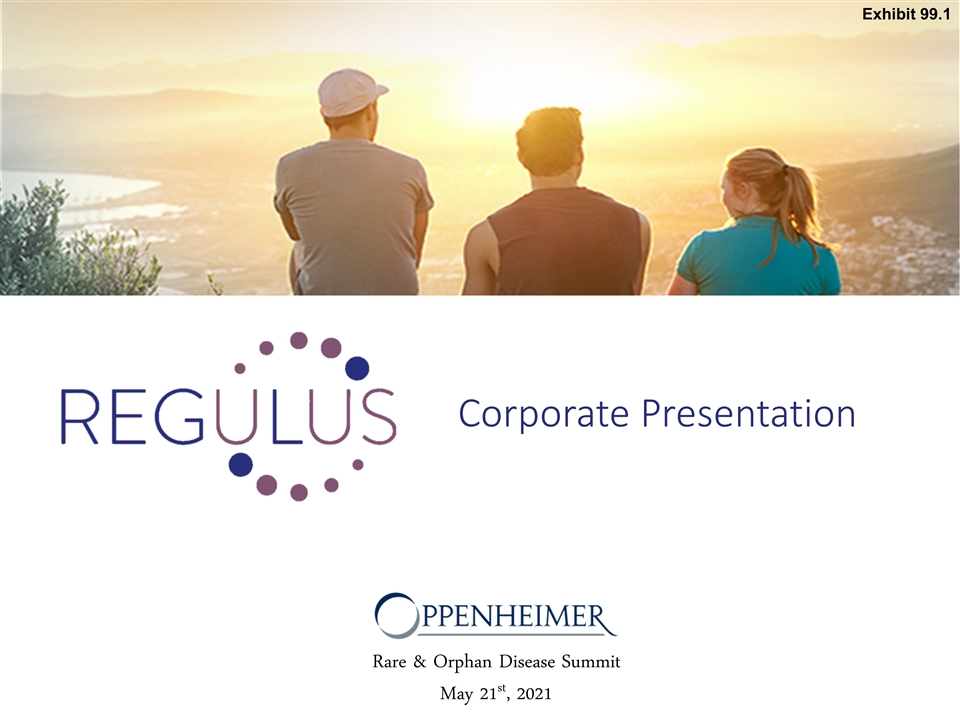
Corporate Presentation Rare & Orphan Disease Summit May 21st, 2021 Exhibit 99.1
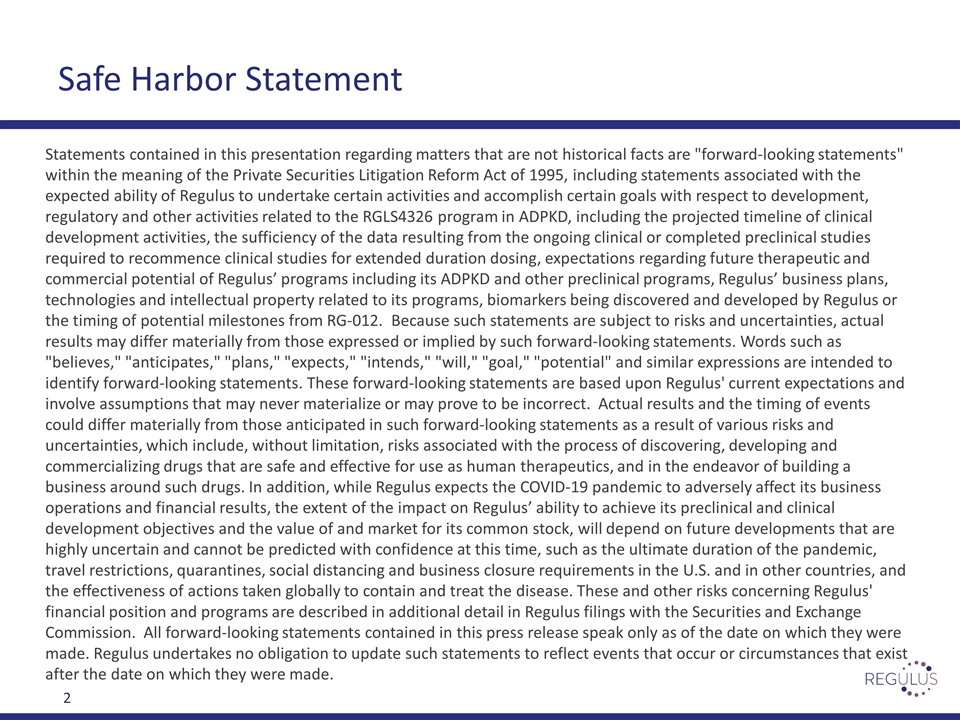
Safe Harbor Statement Statements contained in this presentation regarding matters that are not historical facts are "forward-looking statements" within the meaning of the Private Securities Litigation Reform Act of 1995, including statements associated with the expected ability of Regulus to undertake certain activities and accomplish certain goals with respect to development, regulatory and other activities related to the RGLS4326 program in ADPKD, including the projected timeline of clinical development activities, the sufficiency of the data resulting from the ongoing clinical or completed preclinical studies required to recommence clinical studies for extended duration dosing, expectations regarding future therapeutic and commercial potential of Regulus’ programs including its ADPKD and other preclinical programs, Regulus’ business plans, technologies and intellectual property related to its programs, biomarkers being discovered and developed by Regulus or the timing of potential milestones from RG-012. Because such statements are subject to risks and uncertainties, actual results may differ materially from those expressed or implied by such forward-looking statements. Words such as "believes," "anticipates," "plans," "expects," "intends," "will," "goal," "potential" and similar expressions are intended to identify forward-looking statements. These forward-looking statements are based upon Regulus' current expectations and involve assumptions that may never materialize or may prove to be incorrect. Actual results and the timing of events could differ materially from those anticipated in such forward-looking statements as a result of various risks and uncertainties, which include, without limitation, risks associated with the process of discovering, developing and commercializing drugs that are safe and effective for use as human therapeutics, and in the endeavor of building a business around such drugs. In addition, while Regulus expects the COVID-19 pandemic to adversely affect its business operations and financial results, the extent of the impact on Regulus’ ability to achieve its preclinical and clinical development objectives and the value of and market for its common stock, will depend on future developments that are highly uncertain and cannot be predicted with confidence at this time, such as the ultimate duration of the pandemic, travel restrictions, quarantines, social distancing and business closure requirements in the U.S. and in other countries, and the effectiveness of actions taken globally to contain and treat the disease. These and other risks concerning Regulus' financial position and programs are described in additional detail in Regulus filings with the Securities and Exchange Commission. All forward-looking statements contained in this press release speak only as of the date on which they were made. Regulus undertakes no obligation to update such statements to reflect events that occur or circumstances that exist after the date on which they were made.
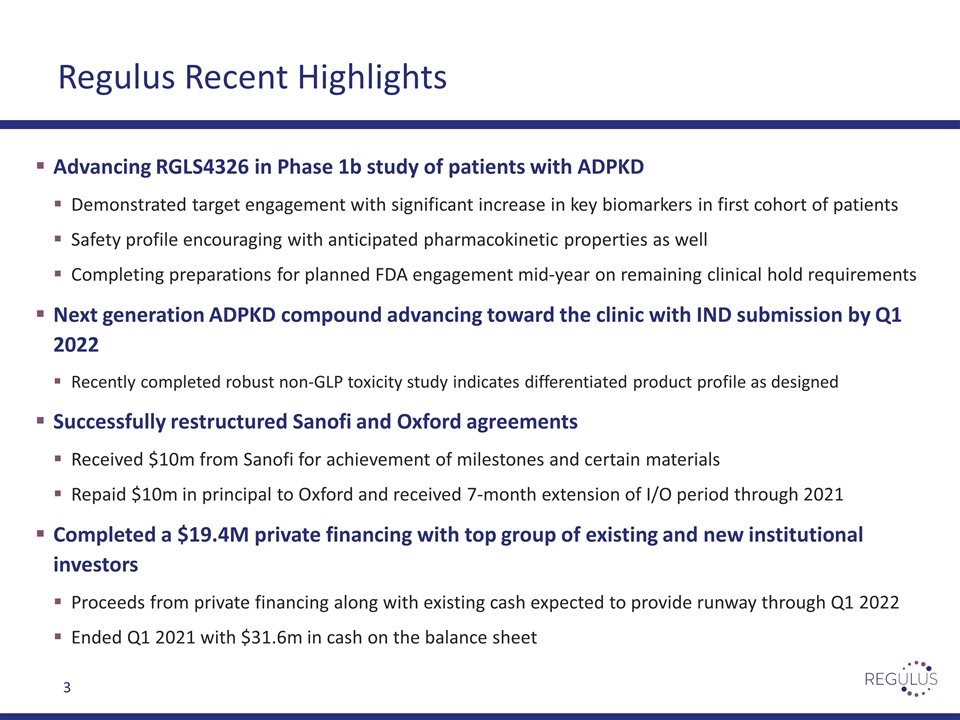
Advancing RGLS4326 in Phase 1b study of patients with ADPKD Demonstrated target engagement with significant increase in key biomarkers in first cohort of patients Safety profile encouraging with anticipated pharmacokinetic properties as well Completing preparations for planned FDA engagement mid-year on remaining clinical hold requirements Next generation ADPKD compound advancing toward the clinic with IND submission by Q1 2022 Recently completed robust non-GLP toxicity study indicates differentiated product profile as designed Successfully restructured Sanofi and Oxford agreements Received $10m from Sanofi for achievement of milestones and certain materials Repaid $10m in principal to Oxford and received 7-month extension of I/O period through 2021 Completed a $19.4M private financing with top group of existing and new institutional investors Proceeds from private financing along with existing cash expected to provide runway through Q1 2022 Ended Q1 2021 with $31.6m in cash on the balance sheet Regulus Recent Highlights
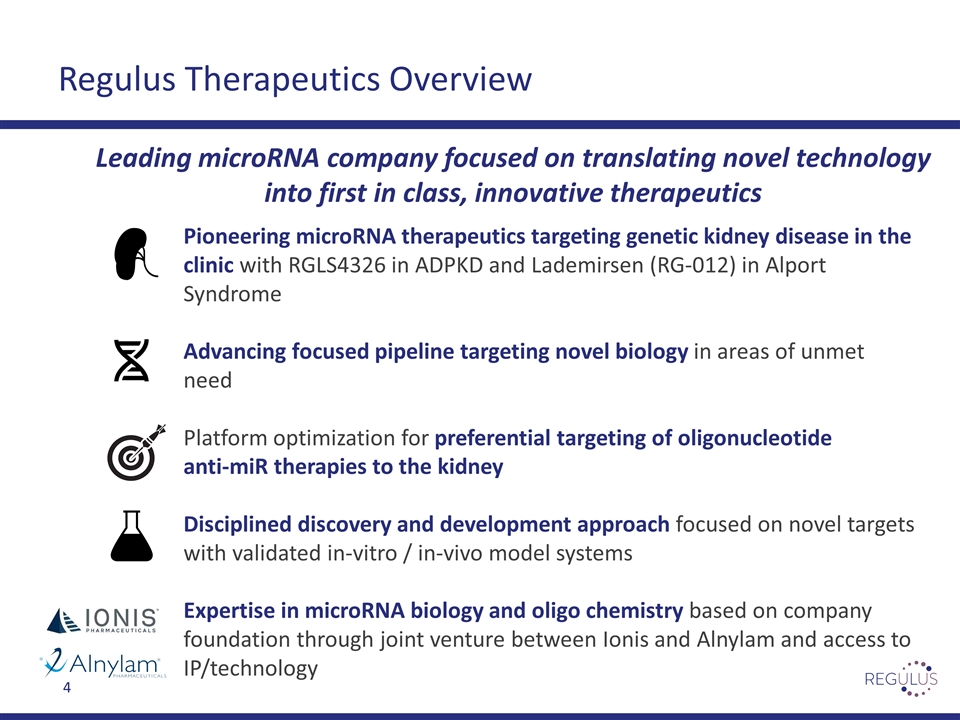
Regulus Therapeutics Overview Leading microRNA company focused on translating novel technology into first in class, innovative therapeutics Pioneering microRNA therapeutics targeting genetic kidney disease in the clinic with RGLS4326 in ADPKD and Lademirsen (RG-012) in Alport Syndrome Advancing focused pipeline targeting novel biology in areas of unmet need Platform optimization for preferential targeting of oligonucleotide anti-miR therapies to the kidney Disciplined discovery and development approach focused on novel targets with validated in-vitro / in-vivo model systems Expertise in microRNA biology and oligo chemistry based on company foundation through joint venture between Ionis and Alnylam and access to IP/technology

Research & Development Pipeline Target Validation Lead Optimization IND enabling Phase 1 Phase 2 Phase 3 Nephrology Alport Syndrome lademirsen* ADPKD** RGLS4326 ADPKD NextGen Research Programs Other Research Programs*** *Formerly RG-012 **Autosomal Dominant Polycystic Kidney Disease *** Examples: Infectious disease, CNS and Cell Therapy
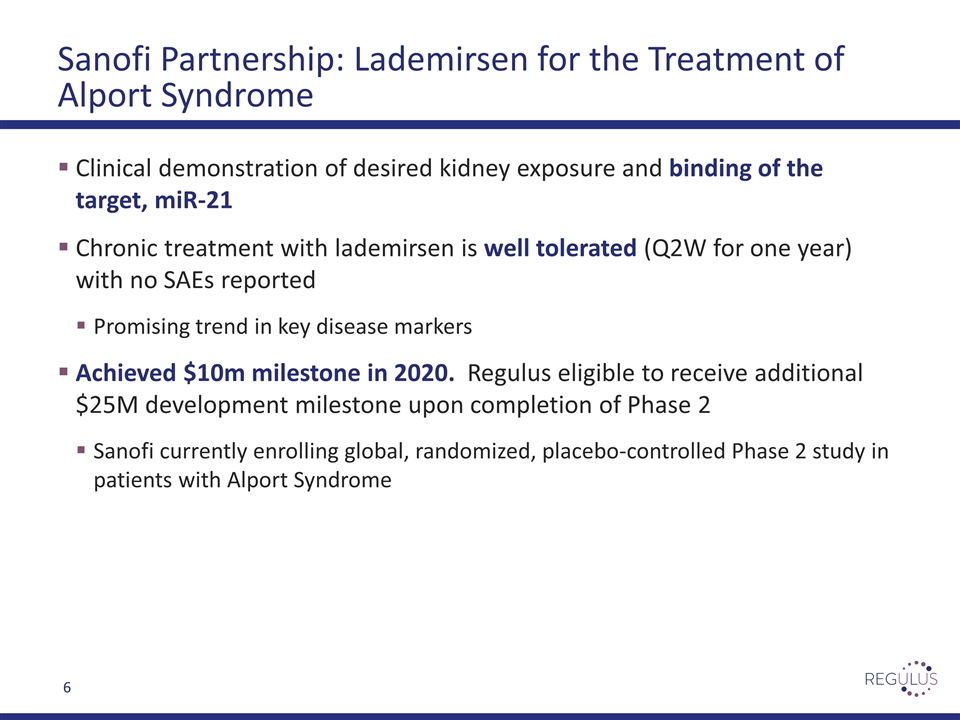
Clinical demonstration of desired kidney exposure and binding of the target, miR-21 Chronic treatment with lademirsen is well tolerated (Q2W for one year) with no SAEs reported Promising trend in key disease markers Achieved $10m milestone in 2020. Regulus eligible to receive additional $25M development milestone upon completion of Phase 2 Sanofi currently enrolling global, randomized, placebo-controlled Phase 2 study in patients with Alport Syndrome Sanofi Partnership: Lademirsen for the Treatment of Alport Syndrome
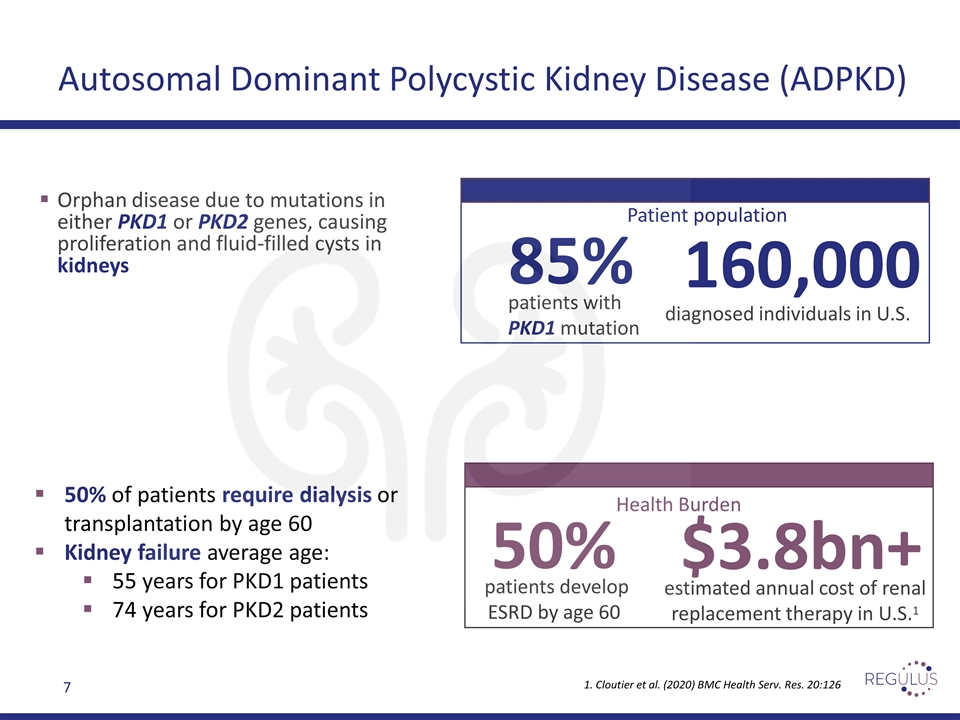
Autosomal Dominant Polycystic Kidney Disease (ADPKD) Orphan disease due to mutations in either PKD1 or PKD2 genes, causing proliferation and fluid-filled cysts in kidneys 85% 160,000 patients with PKD1 mutation diagnosed individuals in U.S. Patient population 50% patients develop ESRD by age 60 Health Burden $3.8bn+ estimated annual cost of renal replacement therapy in U.S.1 1. Cloutier et al. (2020) BMC Health Serv. Res. 20:126 50% of patients require dialysis or transplantation by age 60 Kidney failure average age: 55 years for PKD1 patients 74 years for PKD2 patients
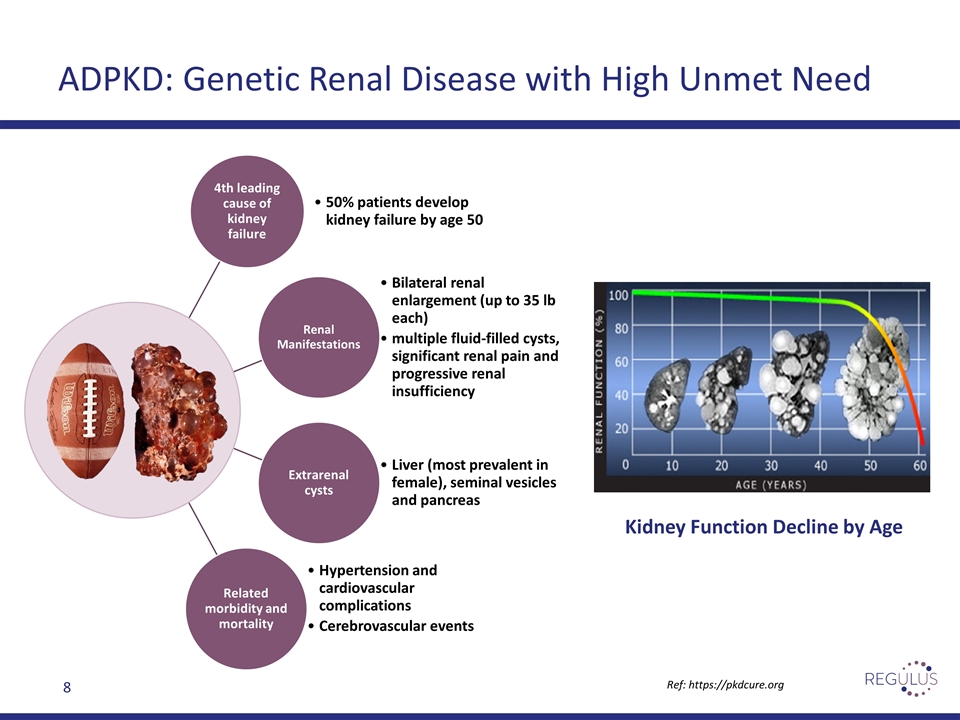
ADPKD: Genetic Renal Disease with High Unmet Need Ref: https://pkdcure.org Kidney Function Decline by Age 4th leading cause of kidney failure 50% patients develop kidney failure by age 50 Renal Manifestations Bilateral renal enlargement (up to 35 lb each) multiple fluid-filled cysts, significant renal pain and progressive renal insufficiency Extrarenal cysts Liver (most prevalent in female), seminal vesicles and pancreas Related morbidity and mortality Hypertension and cardiovascular complications Cerebrovascular events
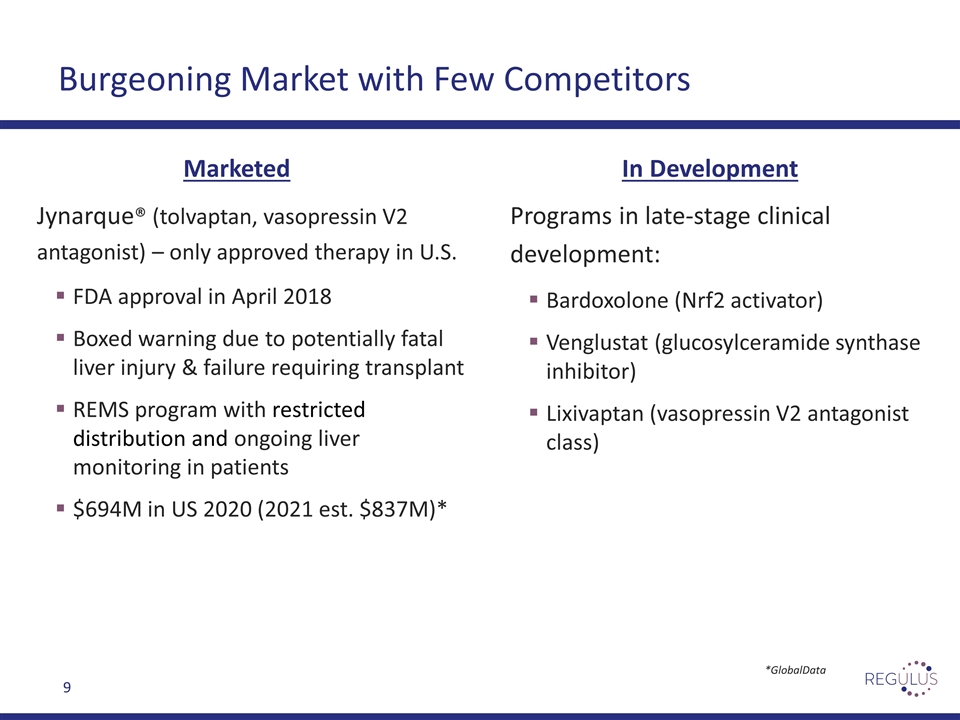
Burgeoning Market with Few Competitors Jynarque® (tolvaptan, vasopressin V2 antagonist) – only approved therapy in U.S. FDA approval in April 2018 Boxed warning due to potentially fatal liver injury & failure requiring transplant REMS program with restricted distribution and ongoing liver monitoring in patients $694M in US 2020 (2021 est. $837M)* Programs in late-stage clinical development: Bardoxolone (Nrf2 activator) Venglustat (glucosylceramide synthase inhibitor) Lixivaptan (vasopressin V2 antagonist class) Marketed In Development *GlobalData
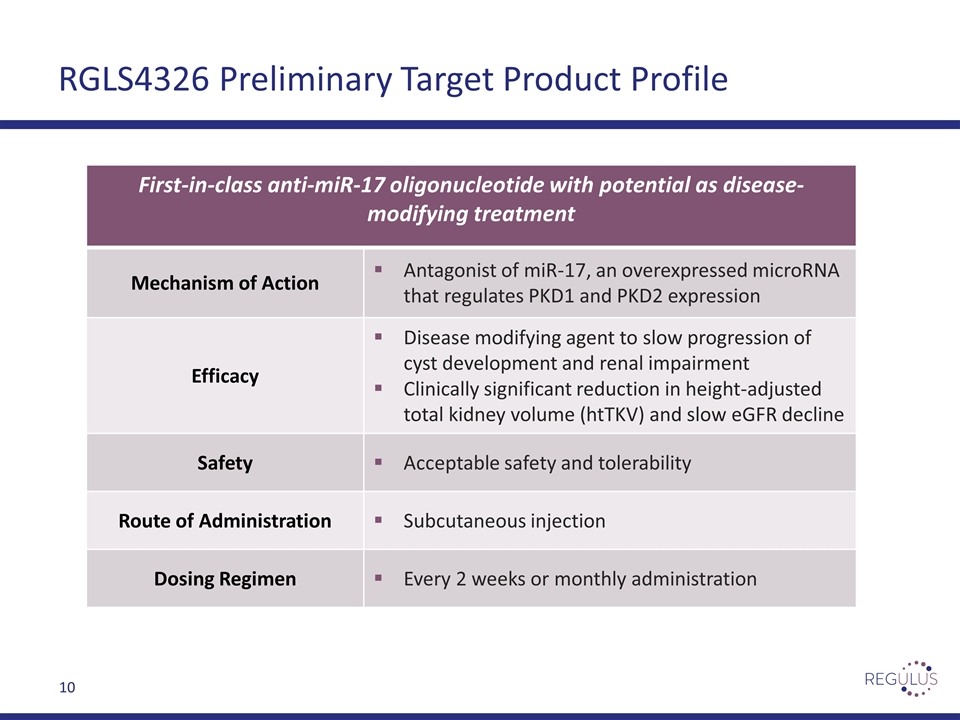
RGLS4326 Preliminary Target Product Profile First-in-class anti-miR-17 oligonucleotide with potential as disease-modifying treatment Mechanism of Action Antagonist of miR-17, an overexpressed microRNA that regulates PKD1 and PKD2 expression Efficacy Disease modifying agent to slow progression of cyst development and renal impairment Clinically significant reduction in height-adjusted total kidney volume (htTKV) and slow eGFR decline Safety Acceptable safety and tolerability Route of Administration Subcutaneous injection Dosing Regimen Every 2 weeks or monthly administration
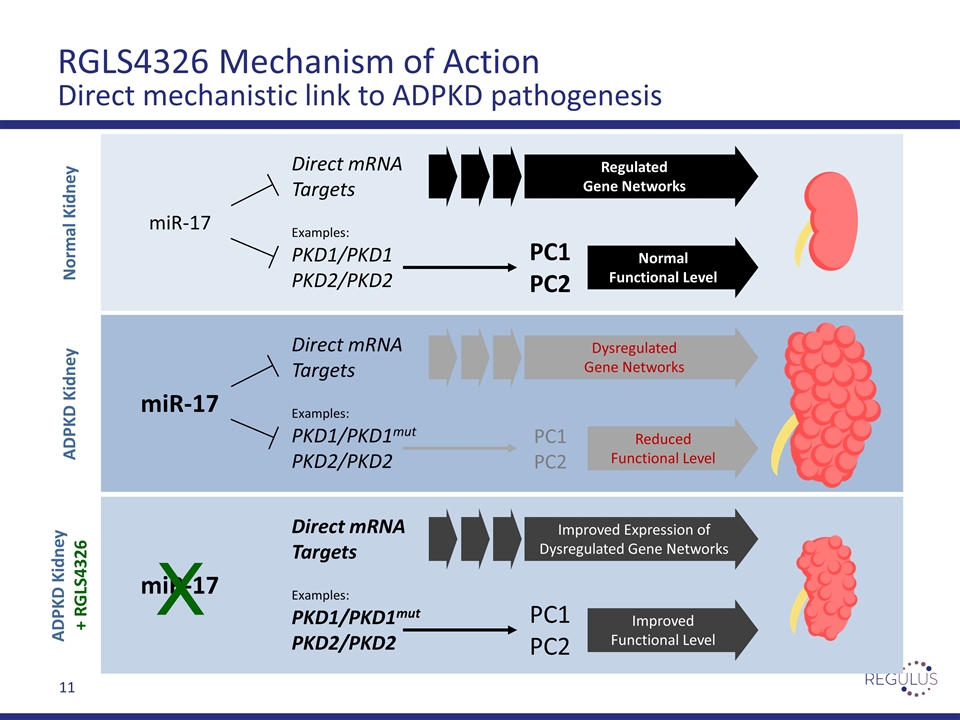
RGLS4326 Mechanism of Action Direct mechanistic link to ADPKD pathogenesis miR-17 PC1 PC2 PKD1/PKD1 PKD2/PKD2 Direct mRNA Targets Regulated Gene Networks Examples: Normal Kidney Normal Functional Level miR-17 PC1 PC2 PKD1/PKD1mut PKD2/PKD2 Direct mRNA Targets Dysregulated Gene Networks Examples: ADPKD Kidney Reduced Functional Level miR-17 PC1 PC2 PKD1/PKD1mut PKD2/PKD2 Direct mRNA Targets Improved Expression of Dysregulated Gene Networks Examples: ADPKD Kidney + RGLS4326 Improved Functional Level X
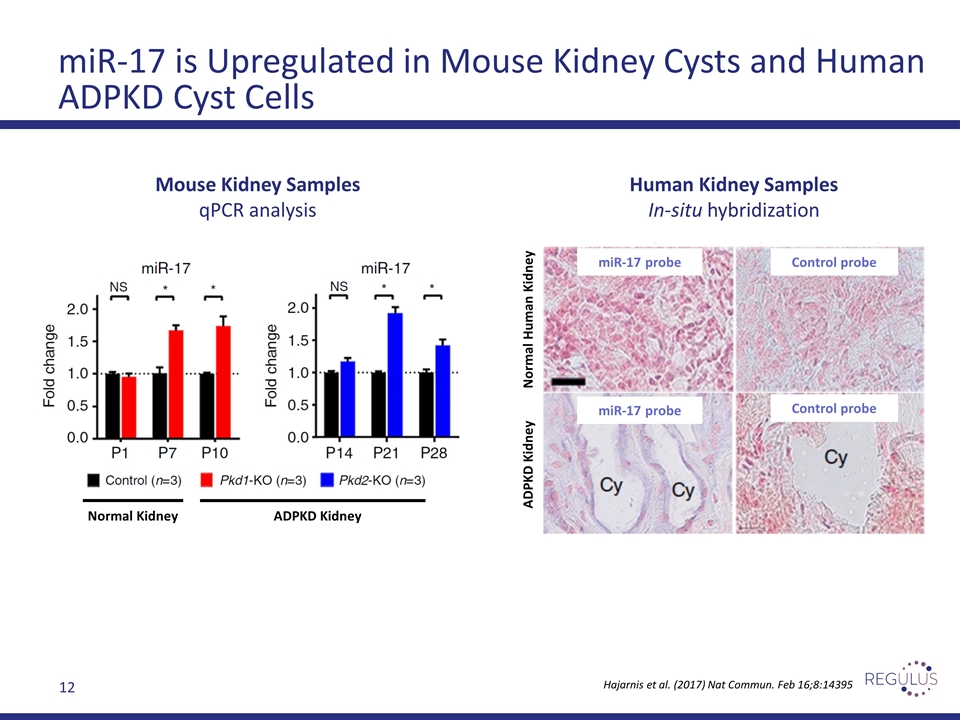
miR-17 is Upregulated in Mouse Kidney Cysts and Human ADPKD Cyst Cells Human Kidney Samples In-situ hybridization Hajarnis et al. (2017) Nat Commun. Feb 16;8:14395 Normal Human Kidney ADPKD Kidney miR-17 probe miR-17 probe Control probe Control probe Mouse Kidney Samples qPCR analysis Normal Kidney ADPKD Kidney
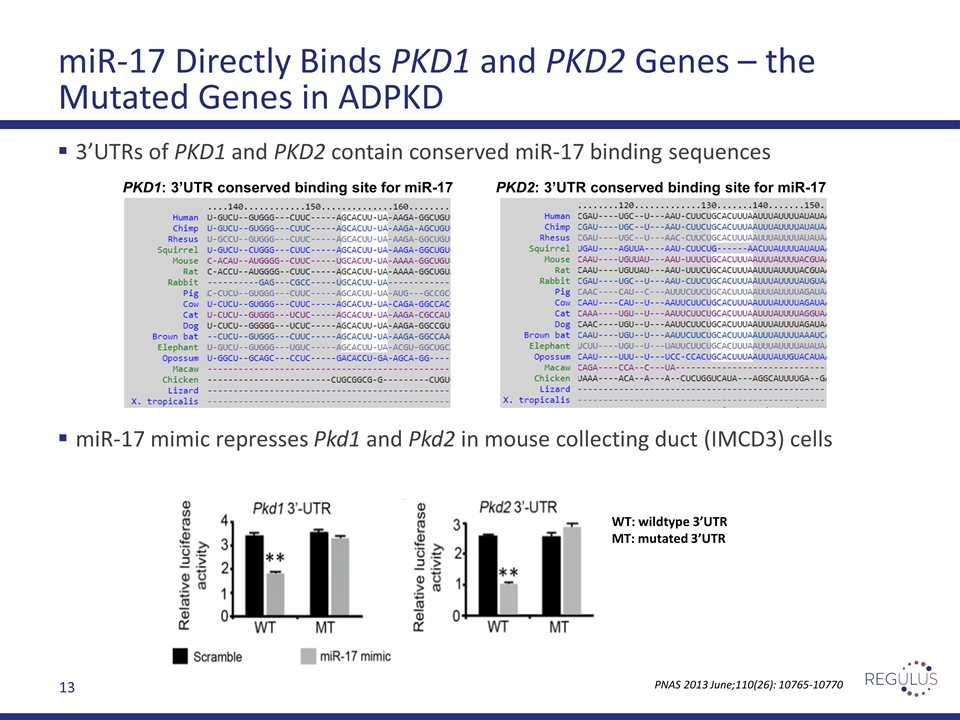
miR-17 Directly Binds PKD1 and PKD2 Genes – the Mutated Genes in ADPKD 3’UTRs of PKD1 and PKD2 contain conserved miR-17 binding sequences miR-17 mimic represses Pkd1 and Pkd2 in mouse collecting duct (IMCD3) cells PNAS 2013 June;110(26): 10765-10770 WT: wildtype 3’UTR MT: mutated 3’UTR PKD1: 3’UTR conserved binding site for miR-17 PKD2: 3’UTR conserved binding site for miR-17
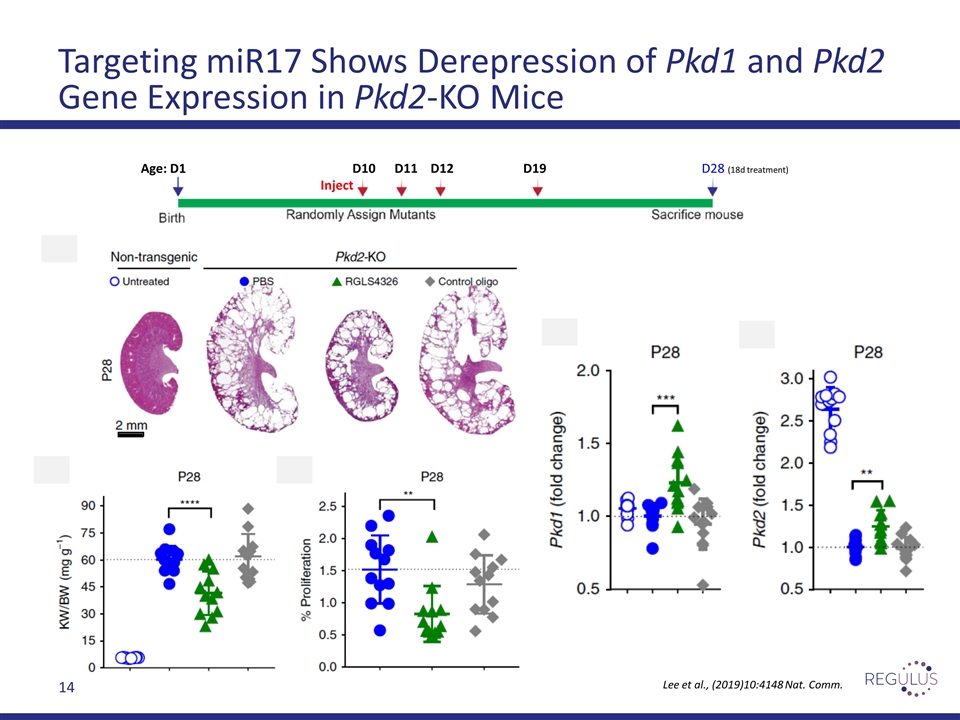
Age: D1 D10 D11 D12 D19 D28 (18d treatment) Targeting miR17 Shows Derepression of Pkd1 and Pkd2 Gene Expression in Pkd2-KO Mice Inject Lee et al., (2019)10:4148 Nat. Comm.
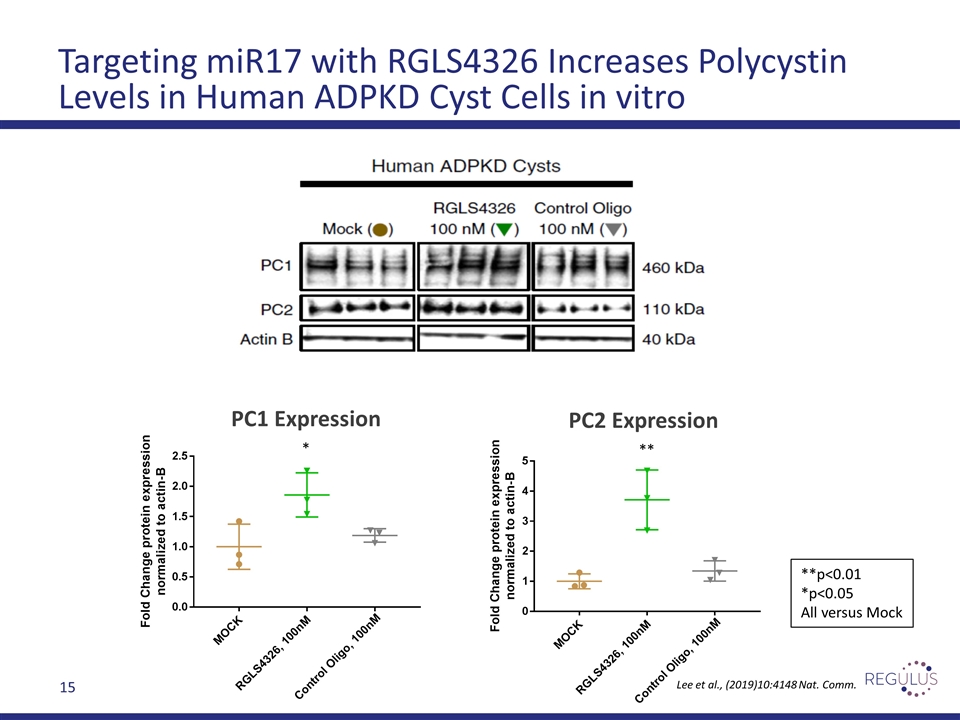
Targeting miR17 with RGLS4326 Increases Polycystin Levels in Human ADPKD Cyst Cells in vitro **p<0.01 *p<0.05 All versus Mock PC1 Expression PC2 Expression * ** Lee et al., (2019)10:4148 Nat. Comm.
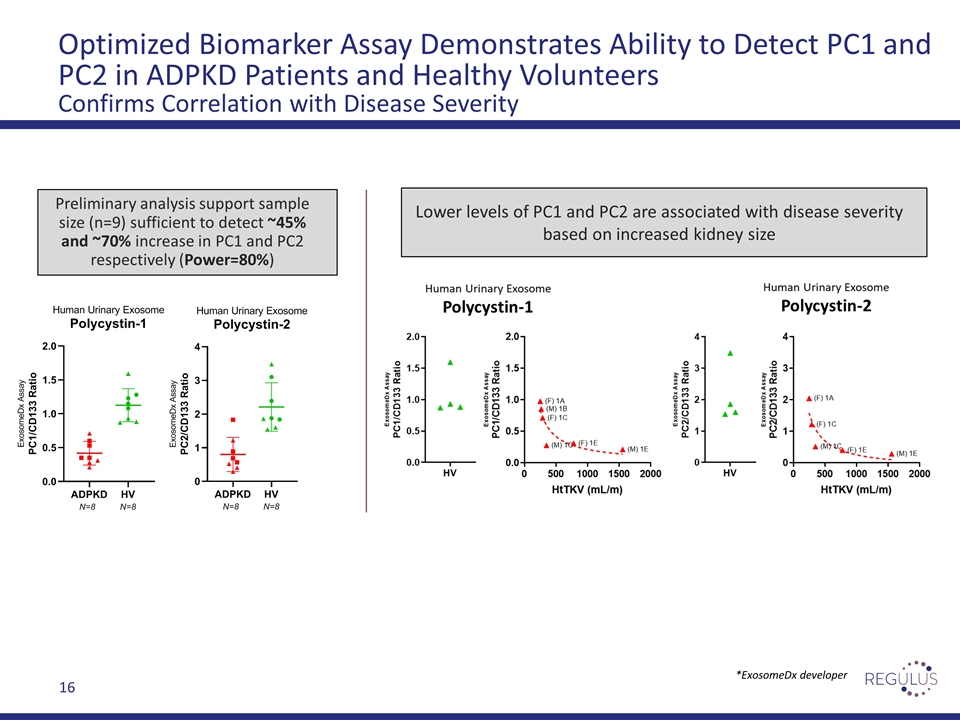
Optimized Biomarker Assay Demonstrates Ability to Detect PC1 and PC2 in ADPKD Patients and Healthy Volunteers Confirms Correlation with Disease Severity Lower levels of PC1 and PC2 are associated with disease severity based on increased kidney size Preliminary analysis support sample size (n=9) sufficient to detect ~45% and ~70% increase in PC1 and PC2 respectively (Power=80%) *ExosomeDx developer
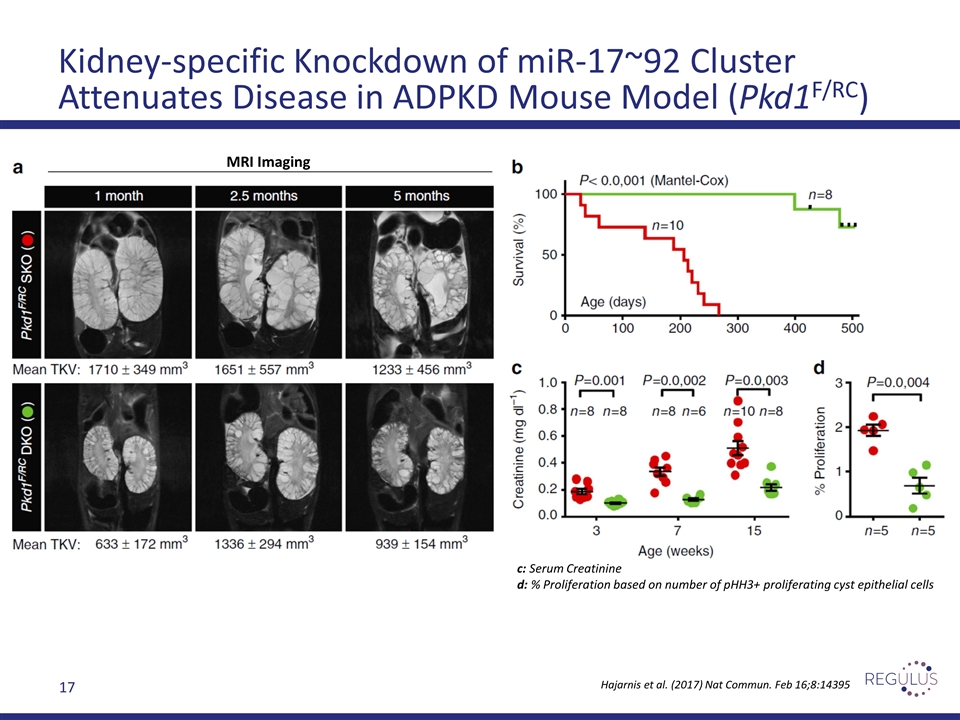
Kidney-specific Knockdown of miR-17~92 Cluster Attenuates Disease in ADPKD Mouse Model (Pkd1F/RC) Hajarnis et al. (2017) Nat Commun. Feb 16;8:14395 MRI Imaging c: Serum Creatinine d: % Proliferation based on number of pHH3+ proliferating cyst epithelial cells
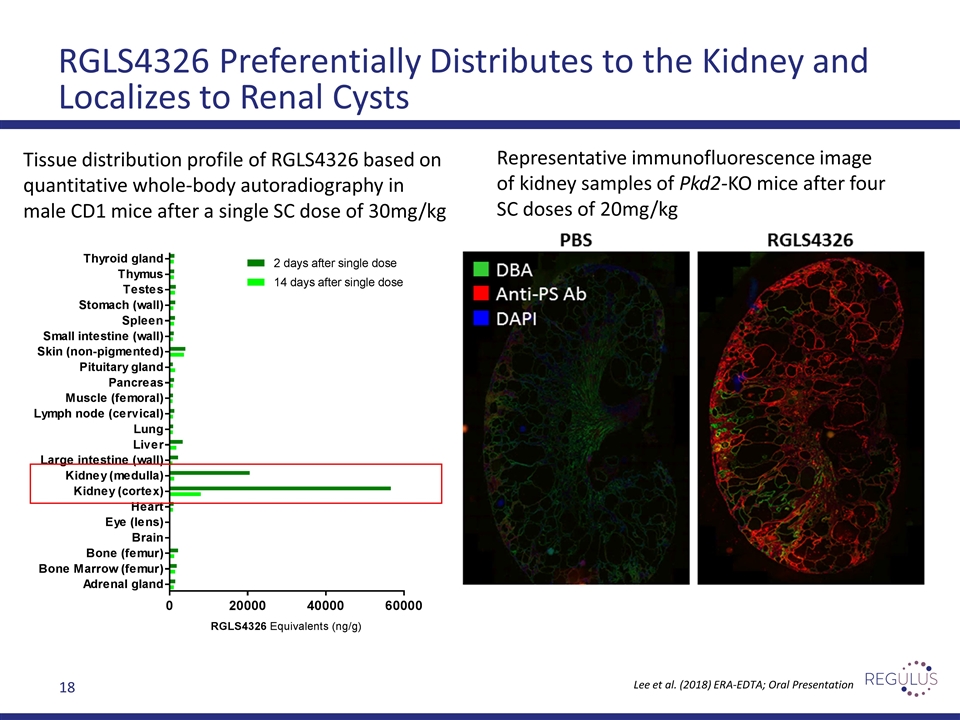
RGLS4326 Preferentially Distributes to the Kidney and Localizes to Renal Cysts Tissue distribution profile of RGLS4326 based on quantitative whole-body autoradiography in male CD1 mice after a single SC dose of 30mg/kg Representative immunofluorescence image of kidney samples of Pkd2-KO mice after four SC doses of 20mg/kg Lee et al. (2018) ERA-EDTA; Oral Presentation

RGLS4326 Shows Favorable PK/PD Profiles After a Single Subcutaneous (SC) Dose of 30 mg/kg Lee et al. (2018) ASN-Kidney Week; Poster Presentation RGLS4326 rapidly absorbed into and cleared from plasma. RGLS4326 distributes primarily to kidney, with kidney-to-liver ratio of >10-fold RGLS4326 potently engages miR-17 peaking on Day 7 post-dose
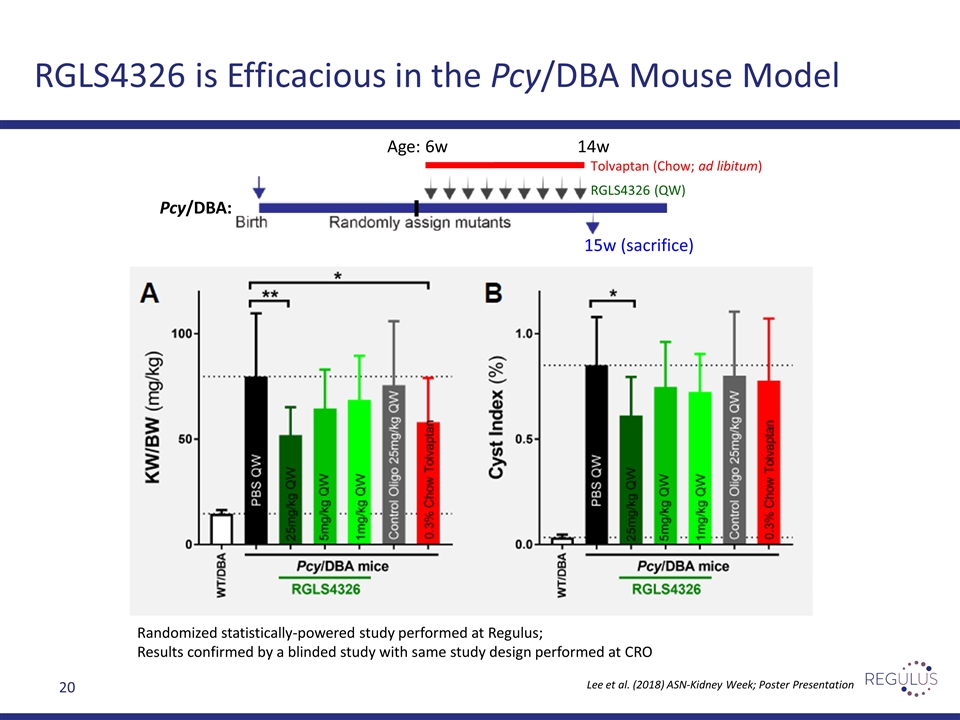
15w (sacrifice) RGLS4326 is Efficacious in the Pcy/DBA Mouse Model Lee et al. (2018) ASN-Kidney Week; Poster Presentation Age: 6w 14w Pcy/DBA: Tolvaptan (Chow; ad libitum) RGLS4326 (QW) Randomized statistically-powered study performed at Regulus; Results confirmed by a blinded study with same study design performed at CRO
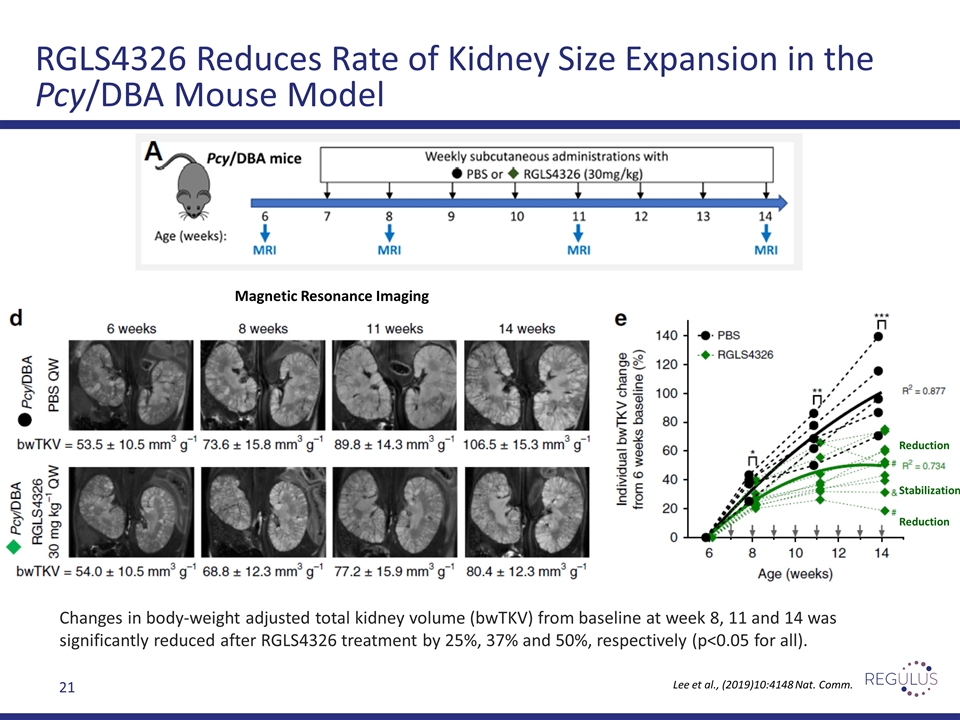
RGLS4326 Reduces Rate of Kidney Size Expansion in the Pcy/DBA Mouse Model Changes in body-weight adjusted total kidney volume (bwTKV) from baseline at week 8, 11 and 14 was significantly reduced after RGLS4326 treatment by 25%, 37% and 50%, respectively (p<0.05 for all). Stabilization Reduction Reduction Magnetic Resonance Imaging Lee et al., (2019)10:4148 Nat. Comm.
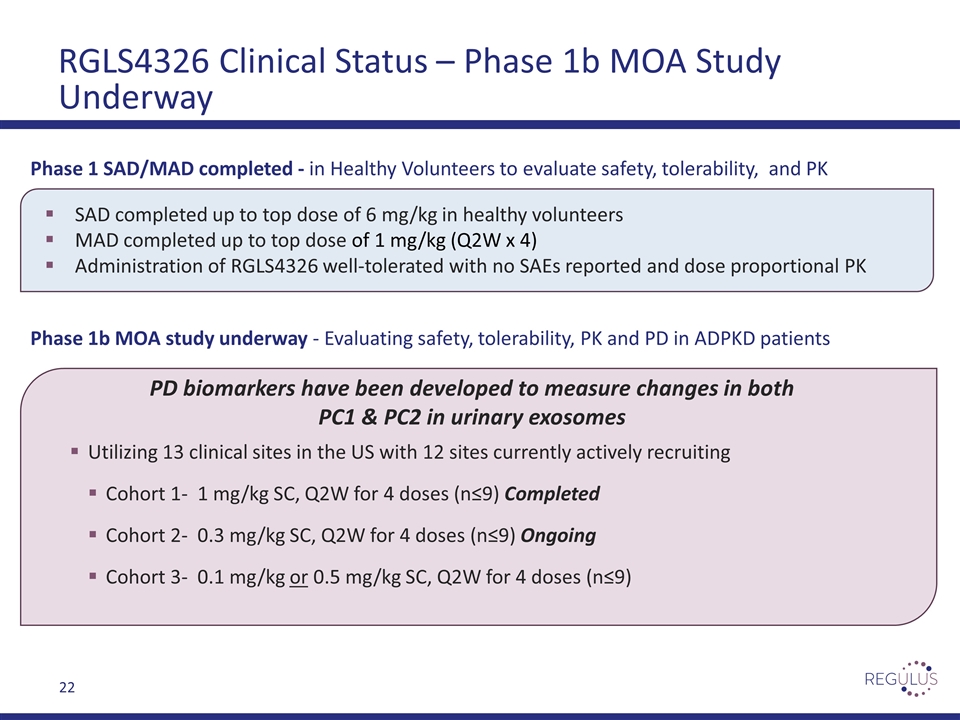
PD biomarkers have been developed to measure changes in both PC1 & PC2 in urinary exosomes Utilizing 13 clinical sites in the US with 12 sites currently actively recruiting Cohort 1- 1 mg/kg SC, Q2W for 4 doses (n≤9) Completed Cohort 2- 0.3 mg/kg SC, Q2W for 4 doses (n≤9) Ongoing Cohort 3- 0.1 mg/kg or 0.5 mg/kg SC, Q2W for 4 doses (n≤9) RGLS4326 Clinical Status – Phase 1b MOA Study Underway SAD completed up to top dose of 6 mg/kg in healthy volunteers MAD completed up to top dose of 1 mg/kg (Q2W x 4) Administration of RGLS4326 well-tolerated with no SAEs reported and dose proportional PK Phase 1 SAD/MAD completed - in Healthy Volunteers to evaluate safety, tolerability, and PK Phase 1b MOA study underway - Evaluating safety, tolerability, PK and PD in ADPKD patients
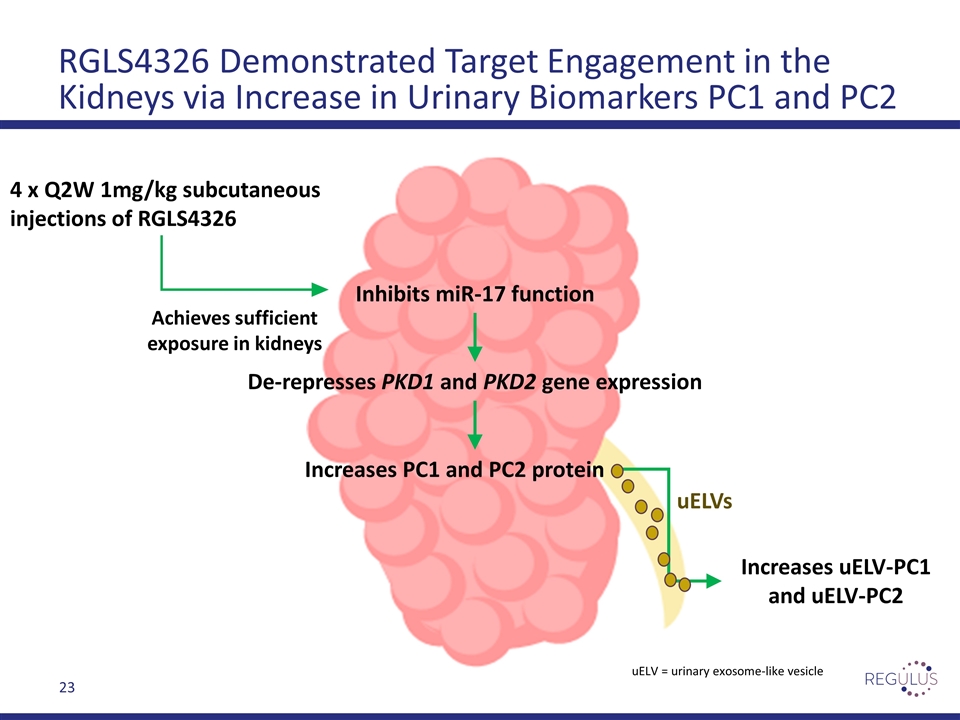
RGLS4326 Demonstrated Target Engagement in the Kidneys via Increase in Urinary Biomarkers PC1 and PC2 4 x Q2W 1mg/kg subcutaneous injections of RGLS4326 Achieves sufficient exposure in kidneys Inhibits miR-17 function De-represses PKD1 and PKD2 gene expression Increases PC1 and PC2 protein Increases uELV-PC1 and uELV-PC2 uELVs uELV = urinary exosome-like vesicle
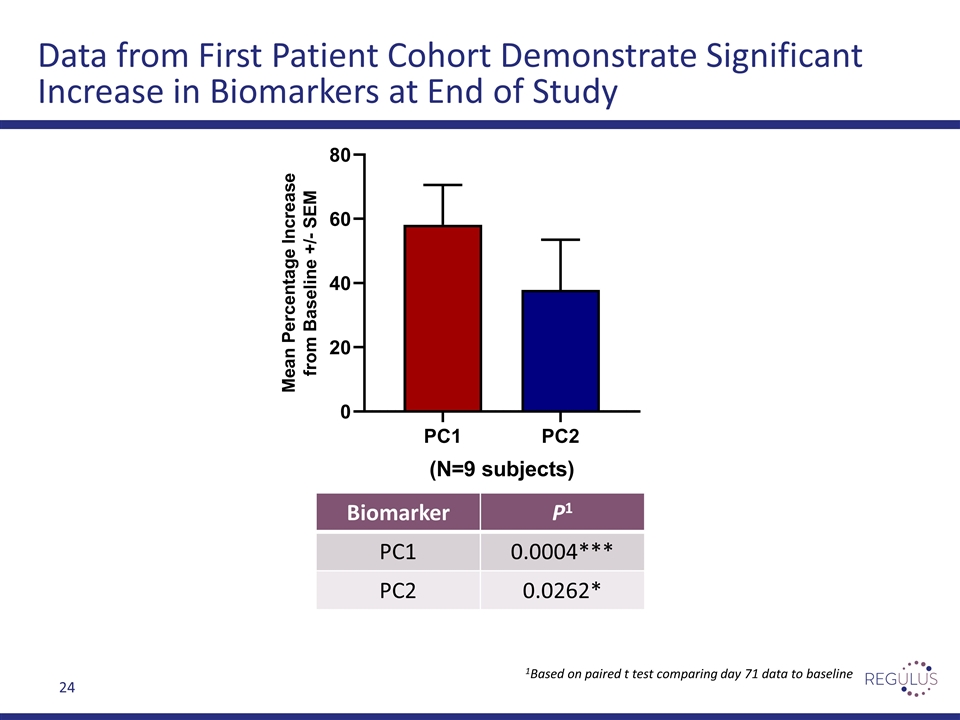
Data from First Patient Cohort Demonstrate Significant Increase in Biomarkers at End of Study Biomarker P1 PC1 0.0004*** PC2 0.0262* 1Based on paired t test comparing day 71 data to baseline
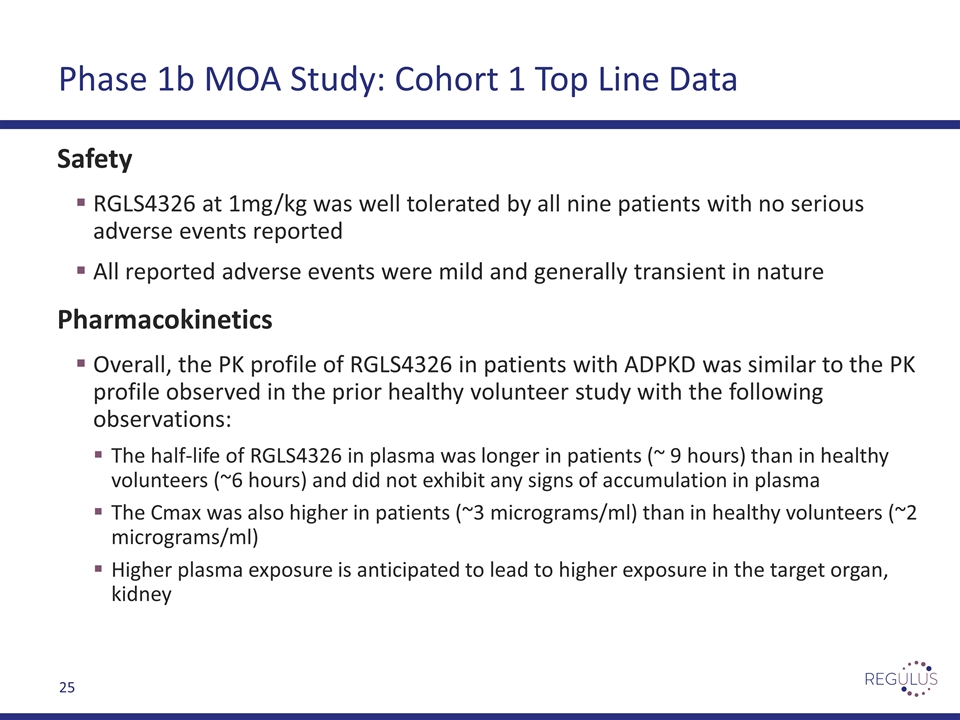
Safety RGLS4326 at 1mg/kg was well tolerated by all nine patients with no serious adverse events reported All reported adverse events were mild and generally transient in nature Pharmacokinetics Overall, the PK profile of RGLS4326 in patients with ADPKD was similar to the PK profile observed in the prior healthy volunteer study with the following observations: The half-life of RGLS4326 in plasma was longer in patients (~ 9 hours) than in healthy volunteers (~6 hours) and did not exhibit any signs of accumulation in plasma The Cmax was also higher in patients (~3 micrograms/ml) than in healthy volunteers (~2 micrograms/ml) Higher plasma exposure is anticipated to lead to higher exposure in the target organ, kidney Phase 1b MOA Study: Cohort 1 Top Line Data
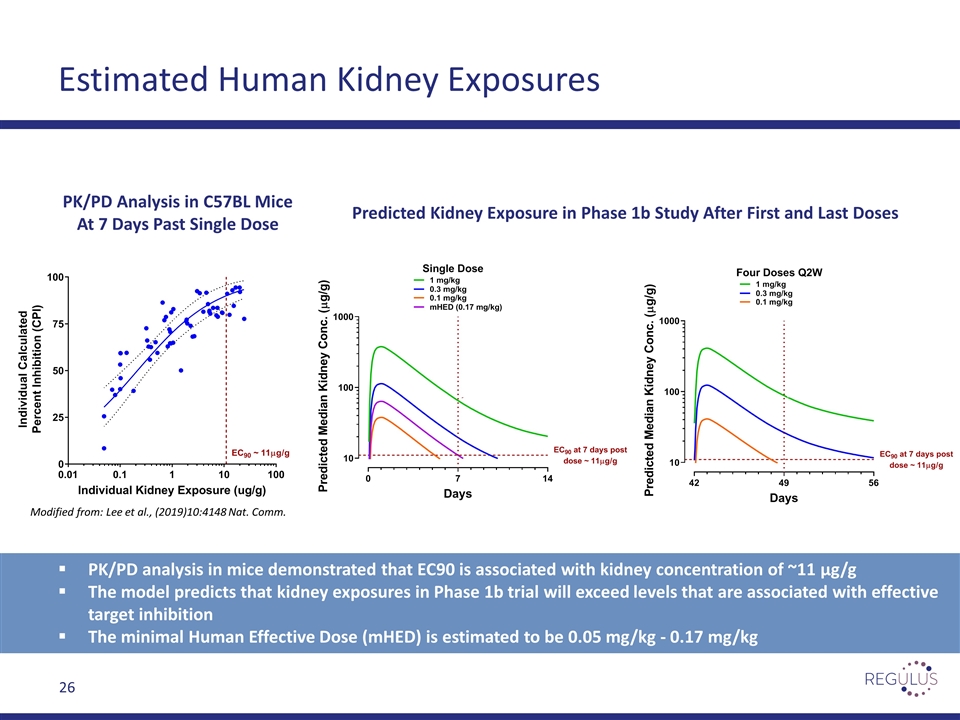
Estimated Human Kidney Exposures Predicted Kidney Exposure in Phase 1b Study After First and Last Doses PK/PD Analysis in C57BL Mice At 7 Days Past Single Dose PK/PD analysis in mice demonstrated that EC90 is associated with kidney concentration of ~11 μg/g The model predicts that kidney exposures in Phase 1b trial will exceed levels that are associated with effective target inhibition The minimal Human Effective Dose (mHED) is estimated to be 0.05 mg/kg - 0.17 mg/kg Modified from: Lee et al., (2019)10:4148 Nat. Comm.
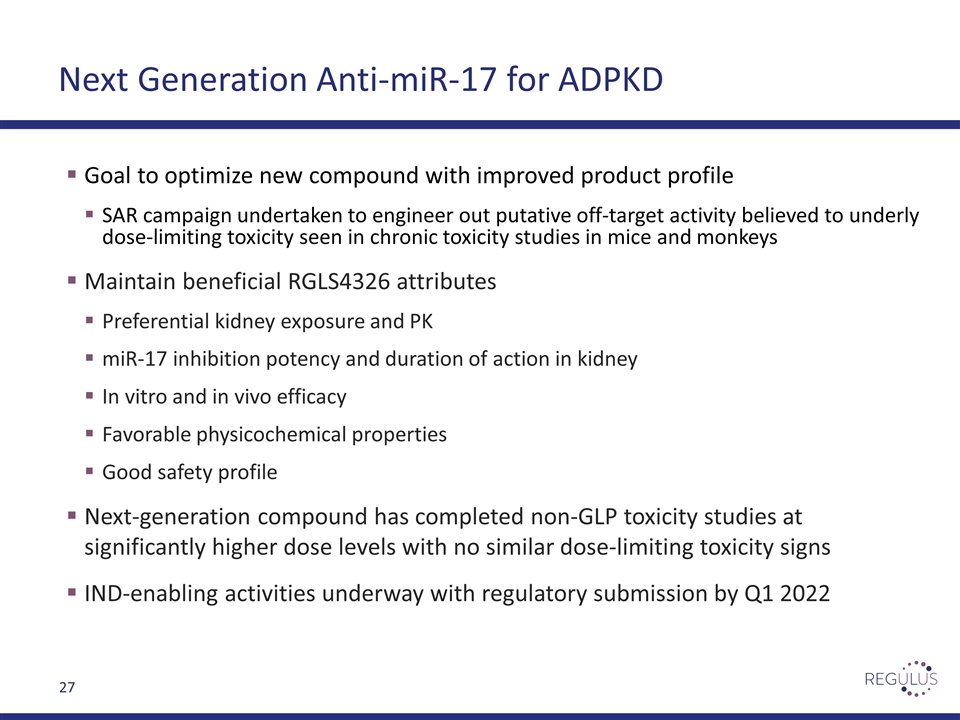
Goal to optimize new compound with improved product profile SAR campaign undertaken to engineer out putative off-target activity believed to underly dose-limiting toxicity seen in chronic toxicity studies in mice and monkeys Maintain beneficial RGLS4326 attributes Preferential kidney exposure and PK miR-17 inhibition potency and duration of action in kidney In vitro and in vivo efficacy Favorable physicochemical properties Good safety profile Next-generation compound has completed non-GLP toxicity studies at significantly higher dose levels with no similar dose-limiting toxicity signs IND-enabling activities underway with regulatory submission by Q1 2022 Next Generation Anti-miR-17 for ADPKD
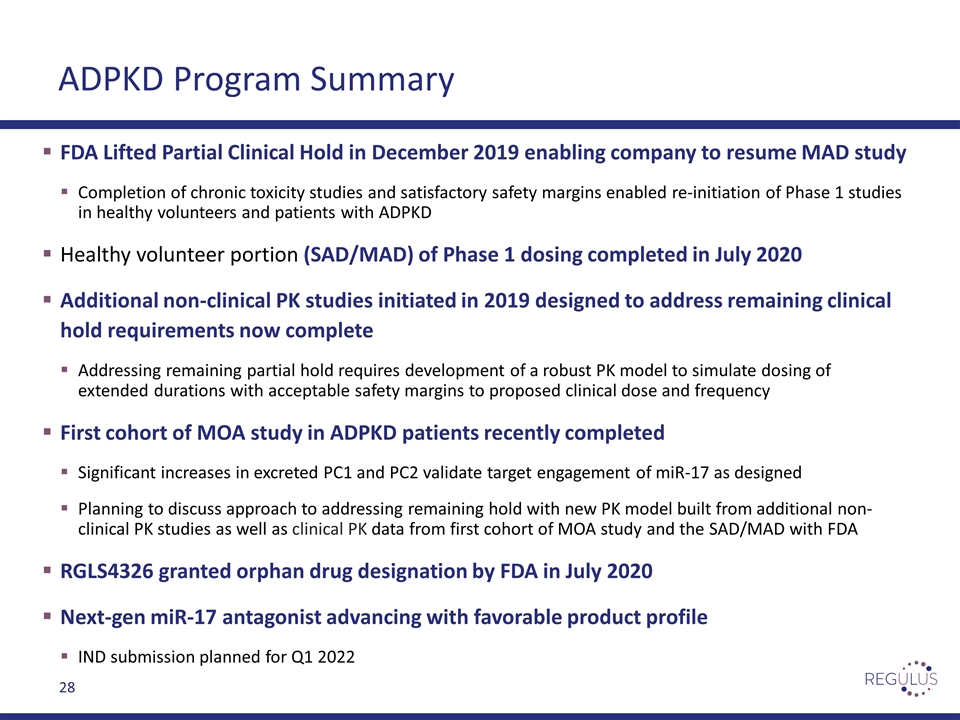
ADPKD Program Summary FDA Lifted Partial Clinical Hold in December 2019 enabling company to resume MAD study Completion of chronic toxicity studies and satisfactory safety margins enabled re-initiation of Phase 1 studies in healthy volunteers and patients with ADPKD Healthy volunteer portion (SAD/MAD) of Phase 1 dosing completed in July 2020 Additional non-clinical PK studies initiated in 2019 designed to address remaining clinical hold requirements now complete Addressing remaining partial hold requires development of a robust PK model to simulate dosing of extended durations with acceptable safety margins to proposed clinical dose and frequency First cohort of MOA study in ADPKD patients recently completed Significant increases in excreted PC1 and PC2 validate target engagement of miR-17 as designed Planning to discuss approach to addressing remaining hold with new PK model built from additional non-clinical PK studies as well as clinical PK data from first cohort of MOA study and the SAD/MAD with FDA RGLS4326 granted orphan drug designation by FDA in July 2020 Next-gen miR-17 antagonist advancing with favorable product profile IND submission planned for Q1 2022
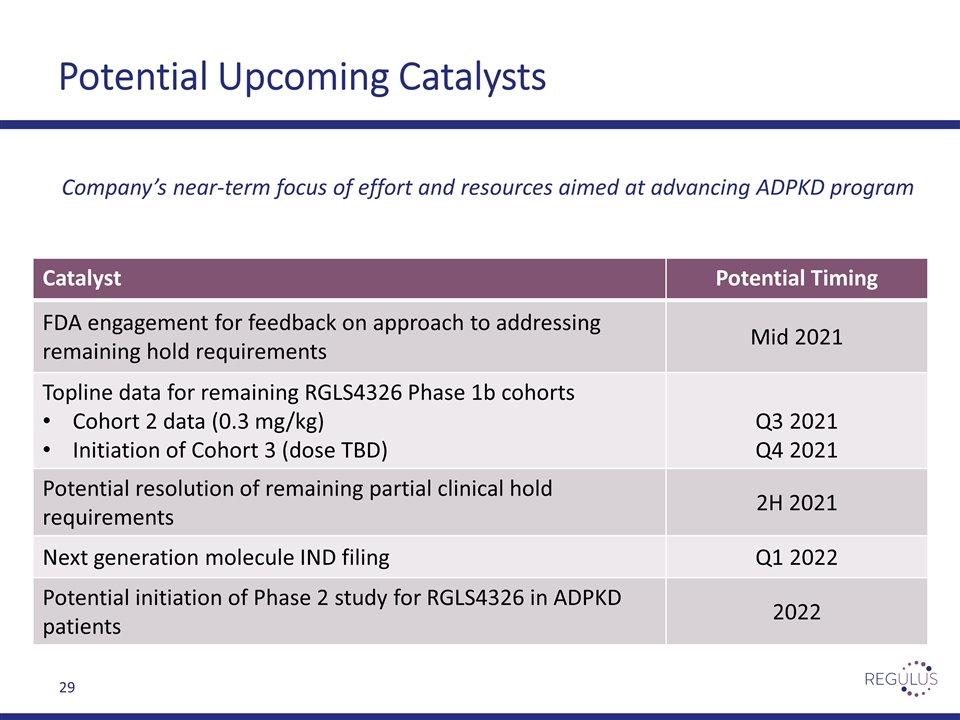
Potential Upcoming Catalysts Catalyst Potential Timing FDA engagement for feedback on approach to addressing remaining hold requirements Mid 2021 Topline data for remaining RGLS4326 Phase 1b cohorts Cohort 2 data (0.3 mg/kg) Initiation of Cohort 3 (dose TBD) Q3 2021 Q4 2021 Potential resolution of remaining partial clinical hold requirements 2H 2021 Next generation molecule IND filing Q1 2022 Potential initiation of Phase 2 study for RGLS4326 in ADPKD patients 2022 Company’s near-term focus of effort and resources aimed at advancing ADPKD program
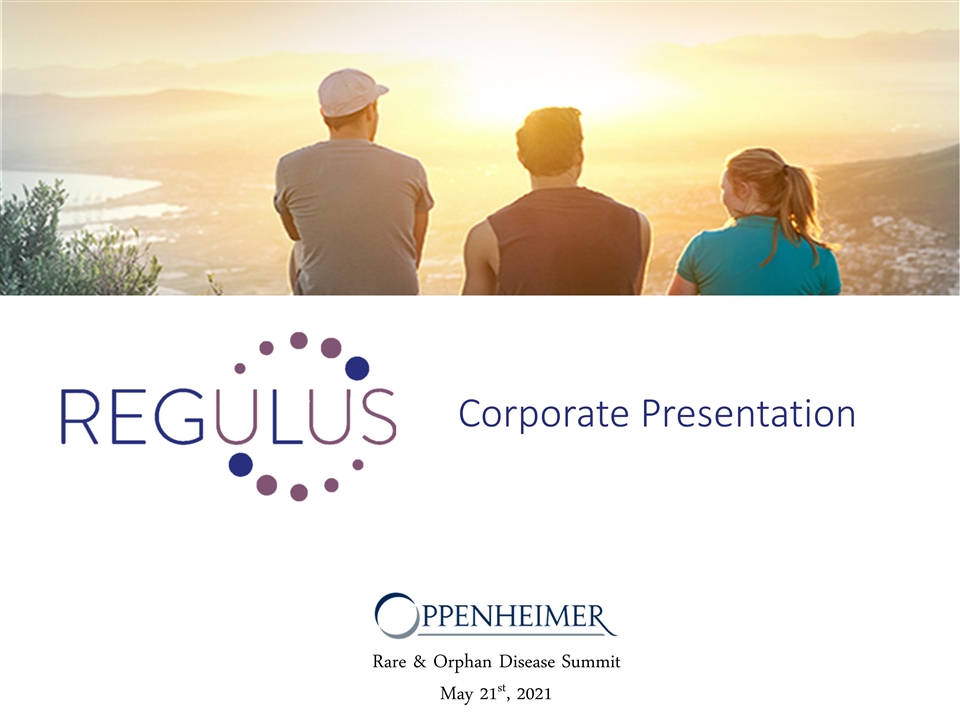
Corporate Presentation Rare & Orphan Disease Summit May 21st, 2021





























